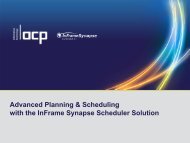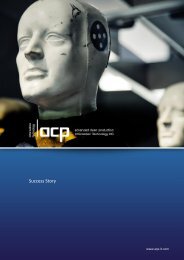Reduction of Factory Ramp-up Time by Early MES Integration using
Reduction of Factory Ramp-up Time by Early MES Integration using
Reduction of Factory Ramp-up Time by Early MES Integration using
Create successful ePaper yourself
Turn your PDF publications into a flip-book with our unique Google optimized e-Paper software.
<strong>Reduction</strong> <strong>of</strong> <strong>Factory</strong> <strong>Ramp</strong>-<strong>up</strong> <strong>Time</strong> <strong>by</strong> <strong>Early</strong> <strong>MES</strong><br />
<strong>Integration</strong> <strong>using</strong> InFrame Synapse Platform<br />
Dipl.Ing. Laurentiu A. Maniu, Dipl.Ing. Artur M. Kuczapski<br />
acp-IT SRL<br />
info@acp-it.com<br />
+40 356 711240<br />
Brancusi 7, RO-300050 Timisoara<br />
Abstract<br />
In nowadays, all modern factories are controlled <strong>by</strong> IT systems. Most <strong>of</strong> them are fully<br />
automated and the Manufacturing Execution System (<strong>MES</strong>) controls the activities in the<br />
factories. There are only a few operators in the line, s<strong>up</strong>ervising that the transport systems<br />
and equipments work according to the commands received from the <strong>MES</strong>.<br />
There are several <strong>MES</strong>es on the market, capable <strong>of</strong> fully controlling the processes in a<br />
factory. These are standard systems and must the customized according to each customer<br />
needs and integrated with the equipments which it controls. Unfortunately, only in few<br />
industries there are standards for the integration <strong>of</strong> the <strong>MES</strong> with the equipments and,<br />
also where there are standards, not all equipments implement the compete standards<br />
interfaces. Therefore, it takes a very long time, from several months to a few years, until a<br />
factory can run controlled solely <strong>by</strong> the <strong>MES</strong> system, with no operator control.<br />
In this paper we will present how can be reduced the ramp-<strong>up</strong> time <strong>of</strong> a new factory,<br />
<strong>by</strong> <strong>using</strong> the solution <strong>of</strong> integrating the <strong>MES</strong> with a virtual factory, solution provided <strong>by</strong><br />
acp-IT’s platform, InFrame Synapse.<br />
acp-IT in Stuttgart, Germany, has proven to be a trusted international partner <strong>of</strong>fering<br />
pr<strong>of</strong>essional s<strong>of</strong>tware solutions and consulting services for high-tech production<br />
industries like semiconductor, electronics, photovoltaic and automotive production.<br />
Especially with regard to Manufacturing Execution System (<strong>MES</strong>), Process Control<br />
Systems (PCS), Equipment <strong>Integration</strong> (EI), Scheduling and Logistics Simulation (LS),<br />
acp-IT provides broad experience and references at well known customers.<br />
InFrame Synapse is the state <strong>of</strong> the art Production Control S<strong>of</strong>tware Platform <strong>of</strong> acp-<br />
IT, which has been developed on Web based technologies and uses a service oriented<br />
architecture, which guarantees high performance and extendibility. InFrame Synapse is a<br />
modular solution, which can be adapted and implemented stepwise according to the<br />
customer needs and capabilities.
Figure 1 - InFrame Synapse Platform Architecture<br />
Based on InFrame Synapse Platform, we are the only providers in the area <strong>of</strong><br />
Production Control S<strong>of</strong>tware Services, which, with s<strong>up</strong>port <strong>of</strong> our platform, cover the full<br />
spectrum <strong>of</strong> a Fab lifecycle, starting from planning <strong>of</strong> the new production facility, till<br />
ramp-<strong>up</strong> and operation phases, and also during technology changes:<br />
Figure 2 - Fab Lifecycle Coverage with InFrame Synapse<br />
- Using InFrame Synapse Simulation Suite, based on Anylogic Simulation Engine,<br />
the customer can plan and optimize the new Fab layout during the Fab planning phase.
- Using InFrame Synapse Emulators, connected with the InFrame Synapse <strong>MES</strong><br />
thru InFrame Synapse PLC-Connector (SECSSII/GEM), a configurable EI bridge<br />
between <strong>MES</strong> and equipments, the customer integrates the control s<strong>of</strong>tware already from<br />
the early ramp-<strong>up</strong> phases.<br />
- Implementation <strong>of</strong> the InFrame Synapse <strong>MES</strong> allows the customer to operate the<br />
Fab in different scenarios, from simple Tracking and Tracing scenarios <strong>up</strong> to active<br />
control <strong>of</strong> complex production facilities, operations and resources, <strong>using</strong> the Scheduler<br />
component.<br />
- Connection and integration <strong>of</strong> InFrame Synapse PCS enables the customer to<br />
perform statistical process control, failure detection and classification and advanced<br />
process control <strong>of</strong> equipment, process and quality data during full-operation phases.<br />
InFrame Synapse Virtual Fab is the newest member <strong>of</strong> the InFrame Synapse Suite,<br />
starting End <strong>of</strong> 2009. In the Virtual Fab, the customer can easily connect the <strong>MES</strong> and<br />
PCS Systems with a virtual production facility, taking advantage <strong>of</strong> the following<br />
innovative features:<br />
- Define and test the feasibility <strong>of</strong> production master data already in the capacity<br />
planning phases.<br />
- Define and test the dispatch rules and scheduling algorithms in the early planning<br />
phases in the virtual environment.<br />
- Start integration, customization and testing <strong>of</strong> the <strong>MES</strong> and PCS systems already<br />
in early planning phases<br />
- Generate <strong>MES</strong> and PCS master data (resource models, process plans, product<br />
definitions etc.) directly from the simulation model used during the capacity planning<br />
phase<br />
- Generate the <strong>MES</strong> dispatch rules and scheduling algorithms for the complex<br />
automated material handling systems out <strong>of</strong> the simulation model. The rules and<br />
algorithms were defined and tested in the planning phases and they must not be redefined<br />
again in the real control system.<br />
- During late operation phases, generate simulation models out <strong>of</strong> the <strong>MES</strong><br />
historical data. This way the customer can simulate new manufacturing scenarios before<br />
deciding on operative changes.<br />
- With a generated simulation model, in operation phases, the customer can<br />
accurately test new dispatching rules and scheduling algorithm and transfer them back to<br />
the <strong>MES</strong>. This way rules which prove to have a negative impact do not reach the<br />
operative system.<br />
- Test different scheduling configurations and policies against the Virtual Fab,<br />
evaluate rescheduling strategies in case <strong>of</strong> out-<strong>of</strong>-plan situations.<br />
- Generate virtual production history data for new <strong>MES</strong> ramp-<strong>up</strong>s in existing<br />
running fabs.<br />
- Generate equipment parameters for the manufacturer requirements based on<br />
production targets (i.e. if a new equipment is to be bought, parameters like equipment<br />
availability and maintenance plans can be generated and send to manufacturers)<br />
- Use the Virtual Fab as training environment for engineers and operators, already<br />
when no equipments are available
Beside these new innovative features, now the standard features <strong>of</strong> our Simulation<br />
Suite can be used and performance evaluated against the real production control systems:<br />
- find out the type and number <strong>of</strong> required equipments already from the future<br />
factory planning phase;<br />
- evaluate different layout alternatives, from throughput and utilization<br />
perspectives;<br />
- inspect possible bottlenecks in the material flow;<br />
- identify a minimal buffering capacity;<br />
- evaluate operator behaviour impact on the Fab output;<br />
- test maximum maintenance time window;<br />
- identify the Fab behaviour in case <strong>of</strong> breakdowns;<br />
- identify scrap probability;<br />
- evaluate performance due to set<strong>up</strong> downtimes caused <strong>by</strong> product change;<br />
With the new Virtual Fab, customers <strong>of</strong> InFrame Synapse can drastically reduce ramp<strong>up</strong><br />
time, as well as easily validate the feasibility <strong>of</strong> changes in production facilities<br />
running at high capacity. The figure below shows how much can be reduced the ramp-<strong>up</strong><br />
time <strong>using</strong> early integration <strong>of</strong> Production Control S<strong>of</strong>tware with the Virtual Fab, the blue<br />
chart showing a regular ramp-<strong>up</strong> plan, while the red chart shows the enhanced one.<br />
Figure 3 - <strong>Reduction</strong> <strong>of</strong> <strong>Ramp</strong>-Up <strong>Time</strong> with Virtual Fab





